This piece was originally published in Full Stop Reviews Supplement #6. You can purchase the issue here or subscribe at our Patreon page.
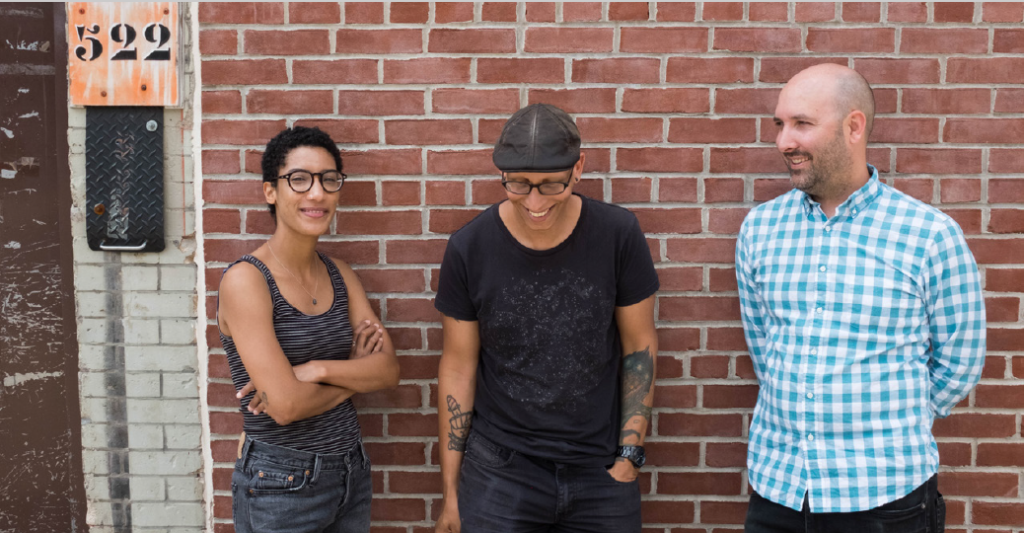
All photos courtesy of Radix Media
I’ve been an admirer of Radix Media and the work they do for a while. I was first introduced to them while working at Unnameable Books, a community bookstore in Prospect Heights, Brooklyn. It wasn’t until I went into Radix for a job interview in November that I really became acquainted with them and learned about the breadth of what they do as a worker-owned, cooperative print shop and publisher. I didn’t get the position, but no harm, no foul! After our meeting, it occurred to me to sit down with them to hear more about their origins and the politics and intention that drive their practice. The resulting interview gave me a window into their day-to-day, their scrappy, as-luck-would-have-it beginnings, and their continuing evolution as a printer and press prioritizing innovative, radical writing and artwork. The best part of this conversation was getting an intimate view into the interests and specialties of Lantz, Nick, and Sarah, and how they came to build and expand Radix.
Rex: Could each of you could introduce yourselves and talk about what you do here, what your roles are?
Nick Hurd: My name is Nick Hurd and I do most of the specialty printing at Radix, so that includes letterpress printing, foil stamping, die-cutting, wide format printing, a lot of production stuff, and a little bit of design.
Rex: Can you elaborate on how you got into that work?
Nick: I went to art school and was interested in studying painting. I didn’t really like the painters that much, I liked the printmakers. I thought they were cooler, so I started hanging out in the printmaking department and got interested in printmaking there. After school, I found a job with a stationery company doing letterpress printing and I’ve been working for a lot of stationery services since then. I started my own little business called Wasp in about 2013. I really wanted to collaborate with other people and get more into publishing and creating more creative projects. I knew Lantz and we were already working together, trading work back and forth based on our specialty areas. Lantz had started Radix Media as a print shop with a cooperative structure. We decided it was a good time to merge our businesses, so I came over to Radix in 2017. We’ve been printing lots of stuff and publishing lots of books ever since.
Lantz Arroyo: My name is Lantz Arroyo. I do a lot of the other production stuff that falls outside of what Nick talked about, including a lot of the digital printing and offset printing. The offset printing is generally used for our own publication work, so I’m basically printing the interior design of our books. Nick or Sarah do the covers and I’ll do the actual interior layout. I also do a lot of customer service, sales, e-mails to clients, pre-press bookkeeping, and some of the other admin work.
Sarah Lopez: I’m Sarah Lopez. I do mostly marketing and publicity. I do all the publicity for the books we put out and I also take care of our social media content. I do some design work and build relationships with bookstores, fairs, and such to get our books out into the world.
Rex: Could you speak to the evolution of Radix from when you first started up to now? How did you start Radix, how did you and Nick meet, and what coop structure you set up in the beginning? Where did those influences come from or what was your background in cooperative/collective spaces?
Nick: Lantz started Radix Media in 2010 and he had already worked in co-ops before. I was printing wedding invitations, business cards, local posters, that kind of stuff, and doing a little bit of book stuff, but not a lot. I just got to a point in what I could do on my own and I was trying to figure out how to do more and grow this little stationery business I had without becoming a traditional business where I just hire people and become the boss. At one point, I hired someone part-time and, to me, that whole relationship was really uncomfortable. The idea of a cooperative was really exciting, where we could all come in with different skillsets and ideas, working together to expand what we did without having a top-down structure. One thing we’ve found is that to be a local print shop, you have to be able to do a lot of different things for a lot of different types of customers. We don’t specialize in one specific thing that we do all the time. As I’ve joined, we added letterpress and foil stamping capabilities to the digital capabilities that I didn’t have in my shop. Now we’ve started to expand to figure out what other services we could offer people. Wide format printing has been a really cool thing because a lot of our customers are already coming to us and asking if we provide things like large vinyl banners for protests, large posters on foam core, and now we are able to provide those things. We’re slowly trying to figure out what new things we can offer, what makes sense for us to grow, and how can we grow with the space we have. A lot of the growth right now is about how to expand the publishing portion of what we do.
Lantz: At first, I started Radix Media as an offset print shop in Portland, Oregon. I sold my car, which I wasn’t using at the time, bought a janky, old single offset press, and accidentally started a business. At the time, I was apprenticing with Eberhardt Press, which is another radical printer and publisher based in Portland. It’s basically this one guy named Charles who was my mentor and continues to be one now. I started doing more shorter-run zines and things like that, which most places wouldn’t run on an offset press for only 100–200 copies because of how much setup is involved. I really was able to cut my teeth on that and also, in those early days, I reprinted zines. The first zine I ever reprinted was Towards a Less Fucked Up World by Nick Riotfag that was out of print. The one I had wasn’t typeset very well, so I got in touch with Nick, got his blessing, redid the layout and reprinted it. That was another way to practice learning all the different tasks involved in printing. In 2012 I relocated back to New York, which is where my family is from originally, and I linked up with OccuCopy, which was a short-run copy place that came out of Occupy Wall Street. That was the first merger to happen because they were exclusively doing digital printing and I was doing exclusively offset printing. They were a collective, but they didn’t really have the structure. I had been working at the Red and Black Cafe in Portland, which is a cafe and event space, and where I learned about worker cooperatives and radical politics in general. I always knew that I wanted Radix to be a worker cooperative. My intention was to link up with other people and build that in. A lot of the early guiding documents and processes I took straight from the Red and Black. It was a good start. I don’t actually remember how or why I met Nick.
Nick: I think we had a mutual friend who said ‘oh, I know both of you guys are into printing’ and so connected us.
Lantz: At the time, we were just starting to build out our letterpress situation because we had just gotten an old press. Nick brought over a lot more letterpress experience, but also two bigger presses that made the older one not needed. It just built up from there.
Rex: Can any and all of you talk to what collective ownership looks like and how cooperative decision-making functions here and in the day-to-day?
Sarah: We start our day off with a production meeting where we talk about what needs to get done and if we need or can offer help. In terms of decision-making, it’s pretty loose because it’s just the three of us and we’re in close proximity. So, someone will have an idea, pitch it, and we’ll talk about it for a bit and move forward.
Lantz: In terms of the process of being on an ownership track: Someone new comes in and it used to be called an apprentice position back when we were only doing printing, but I’m not sure that’s the right word. But, the new person comes in and is learning about all of our processes. When we have meetings, they have a voice, but not a vote. If they have thoughts on a decision we’re trying to make, we always ask for input and work collaboratively. But, someone who just started here can’t vote to dissolve the business or spend $10,000 on a press or something like that. There’s a series of check-ins after starting. The six-month mark is when they can be voted in as a collective member. After one year, they get voted in to be a co-owner. They put in one hundred hours of sweat equity as their buy-in. In lieu of a monetary buy-in, they donate labor. At that point, they get a full vote, take on more responsibility, and become relatively autonomous.
Rex: Can you talk about the press side, how and when publishing came into the mix, and what you’ve published?
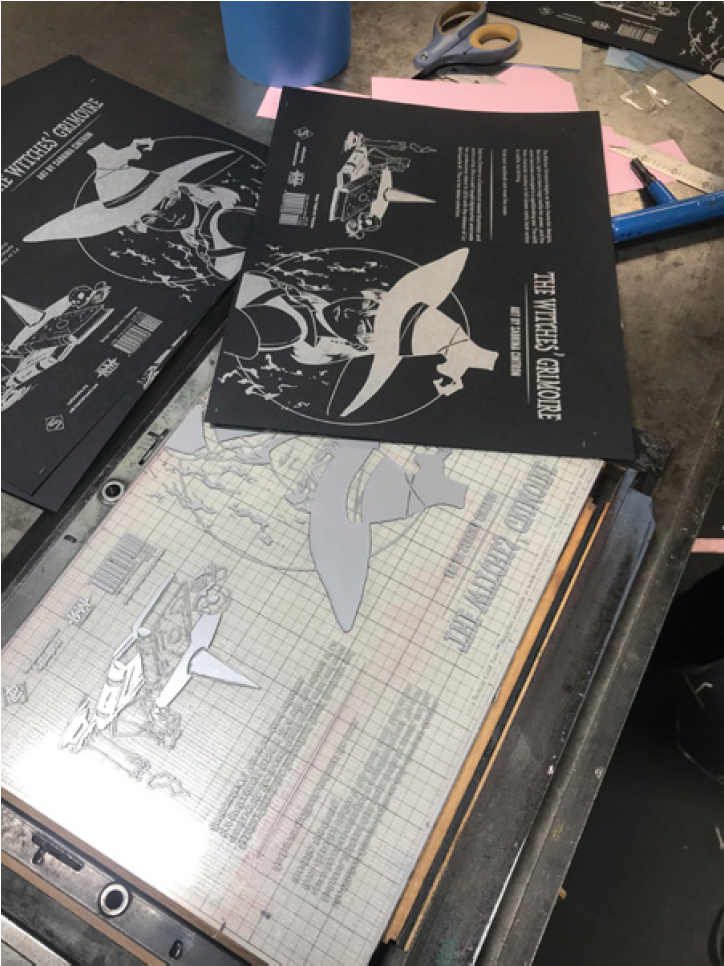
Lantz: As soon as I got that old, janky press back in the day, one of the first things I thought was now I can republish things. I basically made that known that that was my intention to Nick and Sarah when we interviewed her. I would be working here by myself some days and I would be texting Nick harassing him about ideas I had for projects. We haven’t done any of those, but we have done other ones. Our first book was an anthology called Aftermath: Explorations of Loss and Grief that we published in 2018. We did an open call in 2017 for submissions and got like a thousand of them. That was a wild experience because we did all of the editing, design, and everything here, including the many thousands of sheets of printing mostly on our press out there, but anything that was full color on a digital press. The only thing we sent out for that book was the binding to a bindery in New Jersey, which was way better than us trying to finagle it here. We did a coloring book collaboration with Justseeds Artists Cooperative called Be the Change. We published an art book called The Witches’ Grimoire by Sabrina Cintron who is a Puerto-Rican comic book artist who worked on the first issue of the comic La Borinquena. She’s really talented and sweet, and was really stoked at how it came out. Our next project we have coming is also a co-publishing endeavor with Ganzeer and Elliott Colla called We Are All Things, which came out in February.
Sarah: We also published Futures, which was our big pet project of 2019. We published seven short stories and novelettes as chapbooks from all different authors and artists exploring critical, contemporary issues in an imagined future. It’s literary science fiction that takes social justice issues and issues at large and places them in a near future, examining how they affect our interpersonal relationships. Sabrina Cintron was actually the illustrator for one of the chapbooks, A Point of Honor.
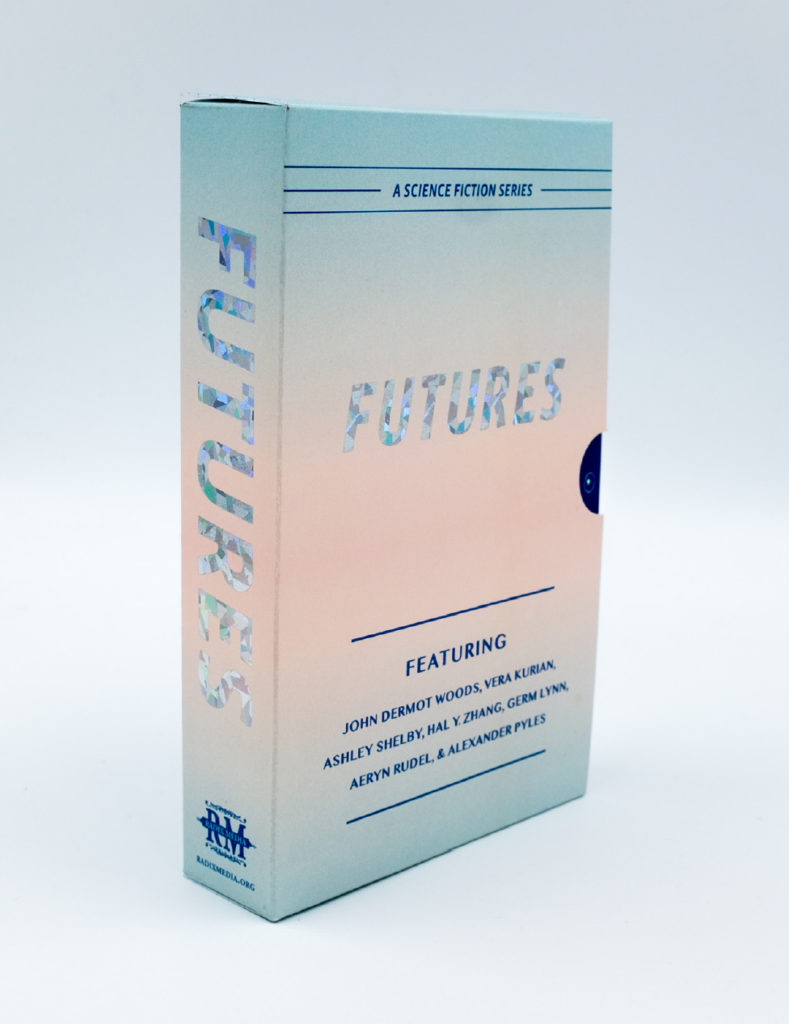
[Radix Media; 2019]
Nick: One of the big pushes in terms of our publishing is to think about the equipment we have, the printing and design knowledge we have, and figure out how to take all of that and utilize it best for publishing great literary works. We’re always looking for submissions and trying to seek out good writers and artists to work with who we think will fit with our political viewpoint and interests. We’re thinking about how we can print something someone wrote, get it illustrated, and print it beautifully in a different way than the publishing world is operating now where you write something, ship it off, and get a book sent back, or maybe it’s even print-on-demand or something like that.
Rex: How did Aftermath and Futures come about as projects?
Sarah: Aftermath was inspired by a short story that Lantz’s friend Joaquin Fernandez wrote called A Beginner’s Guide to Goodbye Sex and it’s about a breakup. A big theme in that was grief. Also, Trump got elected and it brought up a lot of different emotions, so Lantz said let’s publish a book about loss and grief.
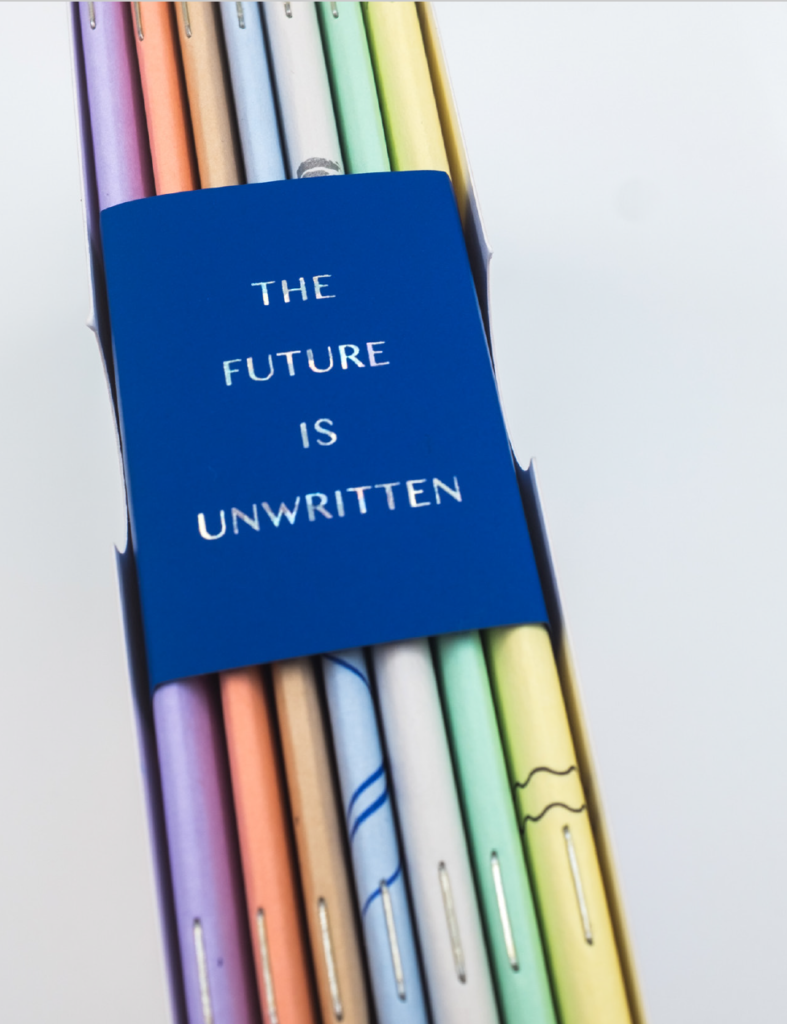
[Radix Media; 2019]
Lantz: Part of it, too, was as we saw from all the submissions we got, a lot of people were taking the obvious viewpoint of grief around a physical tragedy like the death of someone’s parents and such. That’s all obviously valid, but we were also looking at what grief and loss look like in other ways. There’s loss of culture, loss of self. That was why we got so many submissions because we left it very broad. We wanted a lot of different stories. Futures came about because we had spoken to John Dermot Woods who we had done some work with and who wrote Always Blue, which is in the series. He lives really close to us. I reached out to him knowing that I was into his writing and illustration style. I said we were going to be doing more publishing and asked if he had anything. He came in and he had this science fiction story. The story was a lot different then, it changed shape a little in the editing process, but basically we wanted to do the story. Nick or Sarah said, what if we do a series? This was supposed to be our small project after Aftermath, where we do one story a month for seven months. Small, right? The answer to that is no, not small. Much harder in a lot of ways than Aftermath, but we did it and we survived. The box set just came out at the end of November of 2019 and it’s been getting some good feedback.
Rex: What are the politics of Radix? How do they inform or relate to aesthetic values and innovations in the publishing/manufacturing infrastructure and how that differs from larger, traditional outfits?
Sarah: We’re all pretty anti-capitalist and non-hierarchical.
Lantz: Part of it is that we’re not as risk-averse as other publishers might be because we have the printing side, which makes the income and pays all the bills. With those customers, it’s a very transactional relationship. We have lots of people that we do stuff for, they’re regular customers, and we love working with them. But once the specific project is done, that’s it.
Rex: What kind of projects are those?
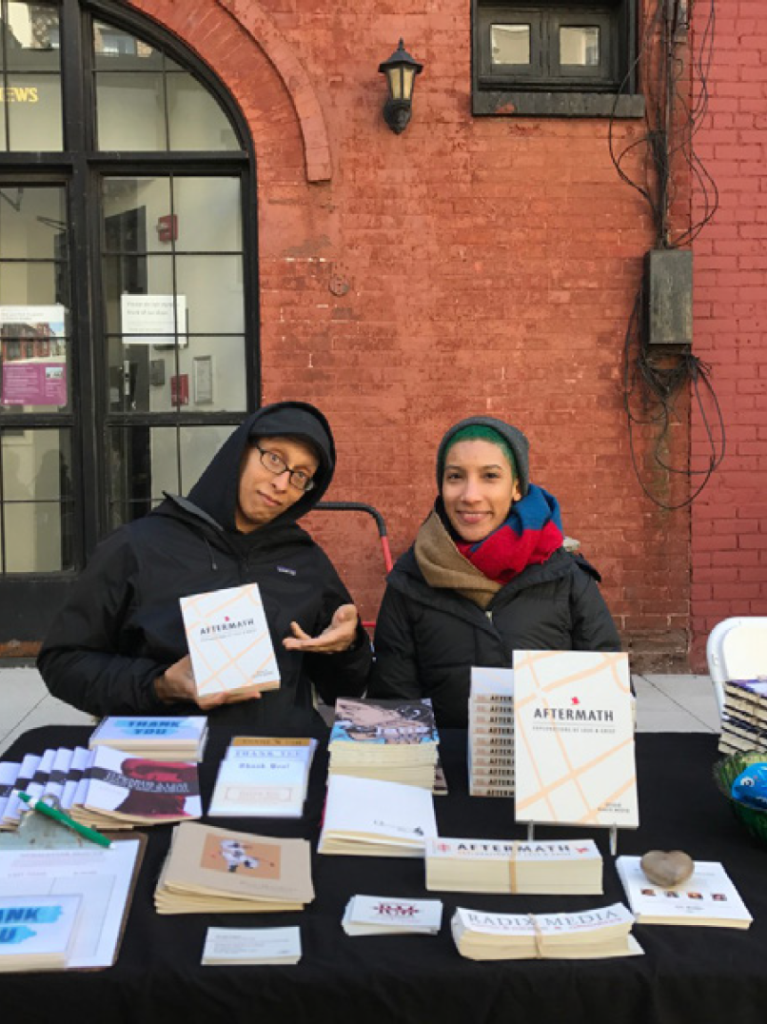
Lantz: We do a lot of business card printing for small businesses, posters, postcards, letterpress and foil stationery, wedding stuff. We have published short runs of galleys and short runs of books for other publishers. We do design, too, so sometimes we’ll design those things as well. Because this commercial printing generates the income, we’re a little more free to explore things that we’re interested in and that we feel other people would be interested in without necessarily putting profit at the top of the list as far as a motive. The other part of it is that when we start developing a project, we really are thinking about it from beginning-to-end. We can make aesthetic choices that will work with our equipment. It’s very much DIY. We’re not really having to rely on a lot of other people and being at their mercy. We own the means of production so that means we can do whatever we want. We also plan and try to make the best decisions, but we’re a bit more agile than other publishers can be. That’s why we were able to do seven books in seven months because we knew what needed to happen to get everything locked down and approved together. It feels like we all have controls over the conditions and that helps us get things done quicker and work on projects that we like.
Sarah: The non-hierarchical aspect also helps us to be more flexible because we all are in charge of our own thing and are better at doing certain things. Overall, we do share tasks and there’s a lot of crossover. If something needs to be done but the person who was going to do it is really busy, someone else can step in and take a little off their plate.
Nick: We have cooperation and collaboration, but also we have shared responsibility as a group. It’s not like one person is sweating it out at the top or the bottom. We create a supportive environment for creating projects in terms of what we work on, but it also really comes out in the finished project.
Lantz: It’s more fulfilling too. You could easily work at a big fat publisher and also work on what ends up being a very nice thing, but I think you don’t actually have your hands on it in the same way. In terms of being a worker at a place, being in a worker cooperative feels more fulfilling because you know that you really have a vested interest, a stake in what’s happening, as well as a voice in the direction of the business.
Nick: One example of that is Futures. I did a little bit of design, but mostly my role was printing the covers. At a normal company, someone would just have given me something to print, I would print it, and I would be paid. But, I feel a lot of ownership over the series because we were all involved in cooperative dialogue. I think everyone feels like that even if they had just one specialty area they worked on in whatever project we’re doing. There’s a real shared responsibility and shared feeling of ownership in everything we make.
Lantz: And you had feedback. Because you were printing the covers, you knew what would or wouldn’t work for the cover because with letterpress you can’t do this or that. You really had feedback that went to the designer to say this needs to be changed. To get that in the beginning is much different than sending the cover out to the printer, the printer says you can’t do that, and then we’re freaking out and behind schedule. To get that information early in the process is really helpful and means we’re designing for our strengths.
Rex: Are there presses throughout time or currently that y’all are inspired by or that you want to build relationships with?
Nick: Generally, the model of the printer throughout history has changed a lot. Most industries become more specialized and insular in our roles and, historically, a printer was not just someone who printed something, they were someone who was typesetting and often the person doing the writing as well. The printer as designer, actual mechanic, person laying down the ink, and also the writer and artist is the historical model we’re looking at.
Sarah: We like Coffee House Press. I personally love MCD Books. I really like presses that push the envelope, experiment with fiction and format, and think about the book as an object.
Lantz: One press I became familiar with recently is Coach House Books. They’re based in Canada and are a printer and publisher. They have two Heidelberg offset presses that they use to print their books. Graywolf Press is doing really amazing stuff right now. I have two kids and I was looking for beautiful children’s books and Nobrow Press, Toon Books, and Fantagraphics make comics and picture books that are such beautiful objects.
•
Check out Radix Media online to learn more about their work, check out their services, and their books, chapbooks, and submissions processes.
rexy la femme (rex renée leonowicz) is a visual + performing artist, writer, and spiritual healer born and raised in Jackson Heights, Queens. As a working class trans femme, rex’s work is grounded in a politics of radical resistance, healing, and witness. rex blends genders and genres, using drag/burlesque, comedy, visual art, and voice, to critically respond to the relationships people “on the margins” have with our surroundings and each other. rex’s book of poems and illustrations, when there is no one and there is everyone, is available from Magic Helicopter Press. find rex online at www.rexylafemme.com and on instagram @rexylafemme.
This post may contain affiliate links.







